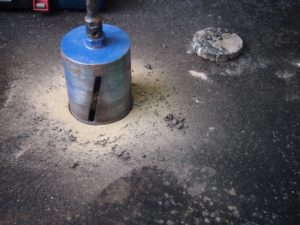
We were asked if we could carry out another investigation into potential sulphate attack in a floor slab this week. The scenario was that the property, a 1960’s bungalow in a Nottinghamshire village, had recently been subject to a homebuyers survey report, which raised concerns with regard to potential sulphate attack in the solid concrete floors. The Chartered Surveyors report contained the usual caveats, “Inspection of the floor was limited due to existing floor coverings” etc. However, the report contained the following statement… “It is noted that some floors to the property are uneven and require further investigation. This type of unevenness felt within the floor is an indication there may be a problem with sulphites in the base to the floors.” Unusual I thought, since sulphites are more usually found in food and wine rather than floor slabs. However, we got the crux of the problem and explained the potential implications to our client when we received the call.

Sulphate attack is caused when sulphates contained within the concrete aggregate contain sulphates or the hardcore sub-base below the concrete contains sulphates. These sulphates react with the Tricalcium Aluminate in ordinary portland cement (OPC) to form Ettringite, a crystal that expands as it grows, in the process often causing substantial damage to the concrete floor slab. Moreover there can be consequential structural damage as heave within the floor can displace internal walls built off the floor or indeed displace brickwork in the outer perimeter walls.
In terms of the investigation process we are looking to establish a number of things.
- How significant is the heave or cracking in the floor slab?
- Is there consequential structural damage?
- Is there a damp proof membrane installed between the floorslab and the hardcore?
- Sampling of both concrete and hardcore for laboratory analysis.
- Measurements to aid providing the client with a budget figure for floor replacement should sulphate attack be confirmed.

On internal visual inspection it was immediately obviously that there was substantial heave to the floorslab in a number of rooms and we pulled up two carpets for a closer inspection. It was obvious to us that there was high probability that the floorslab had failed due to sulphate attack. Sulphate attack is expedited by the present of moisture and we also noted that there were copper central heating pipes running through the concrete floorslab and also the the central heating boiler pressure was low. This raised alarms that a central heating system leak may well be contributing to floor moisture levels. Verdigris on the copper pipes indicated copper corrosion caused by being in direct contact with the highly alkaline concrete.

We set about sampling both the concrete and the hardcore because in our experience, the hardcore is often the prime culprit and the source of sulphates. Obviously, if there was a DPM installed then this barrier between the hardcore and the concrete slab significantly reduces the risk of sulphates coming into contact with the concrete. However, the concrete itself could contain aggregate with a high sulphate content, hence why both the concrete and hardcore are sampled and analysed for sulphates. Additionally we have a cement content analysis carried out on the concrete because this helps us determine the ratio of sulphate to cement, an important factor in determining the severity of failure.

We cored through the floor, initially cutting through an oversite of poured bitumen, which of course acts as a surface applied damp proofing barrier, this in itself told us that we would not find a polyethylene DPM installed. DPM’s started to be installed in floors around 1965 so this property would have been at the very front end of installations had one been installed.
The concrete itself was of very low quality and only circa two inches thick so it didn’t take long to cut through. We packed both a sample of concrete and retrieved a sample of hardcore material before making good the hole with a quick setting concrete mix; we did note that the hardcore material was extremely damp, adding to our concerns regarding a potential subfloor leak. Carpets were replaced and stretched with a knee kicker and we dropped the samples off at our laboratory. We’ve not actually obtained the results yet but we have warned of the very strong possibility that the heave found within these floor slabs is caused by sulphates. The reason for our pessimism, is the obvious visual damage seen to the floors and the poor quality of the hardcore material, which appeared to be crushed builders rubble rather than the usual fly ash or blast furnace waste that can cause this problem. Crushed builders rubble is a low quality hardcore fill material that often contains sulphates.

Our report will contain commentary on any structural implications found and of course will confirm or disprove whether the heave and cracking was caused by sulphates. We will of course also provide additional commentary relating to supplementary factors, such as the leaking central heating system. A budget figure to replace internal floor slabs came in at around £15k, so this is a costly problem to remedy when found.

Leave a Reply